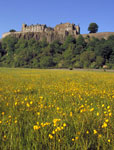|

St Andrews Castle
Stirling Castle
Dunfermline Palace
Huntingtower (Ruthven) Castle
Edinburgh Castle
Huntly Castle
Linlithgow Palace
Dirleton Castle
Mar's Wark
Kelso Abbey

|

 Stirling Castle is located on a volcanic plug (similar to Edinburgh Castle) at the highest navigable point of the Forth. It occupies an important strategic position guarding the principal north-south and east-west routes across Scotland. The first king known to be identified with the castle was Alexander I who built a chapel (1107-1115), but it was during the reigns of James IV and V that the castle took on the magnitude seen today. This is a general view of the castle looking north before the Great Hall had been restored. The buildings seen in this view are mostly the results of the remodelling and modernisation of the castle undertaken in the reigns of James IV and V. As at Edinburgh the castle occupies a summit, or crag, which slopes off into a ridge, or tail, on which the town is built. Stirling Castle is located on a volcanic plug (similar to Edinburgh Castle) at the highest navigable point of the Forth. It occupies an important strategic position guarding the principal north-south and east-west routes across Scotland. The first king known to be identified with the castle was Alexander I who built a chapel (1107-1115), but it was during the reigns of James IV and V that the castle took on the magnitude seen today. This is a general view of the castle looking north before the Great Hall had been restored. The buildings seen in this view are mostly the results of the remodelling and modernisation of the castle undertaken in the reigns of James IV and V. As at Edinburgh the castle occupies a summit, or crag, which slopes off into a ridge, or tail, on which the town is built.
|

















